Blog
Go backSpam: From Canned Ham to Inbox Hell
Deep Dives · July 16th, 2025
The word "spam" didn't always mean that bullshit in your inbox. It started as Hormel's canned meat product originally called "Hormel Spiced Ham" when created in 1927. The name was shortened to "SPAM" in 1937 when Jay Hormel held a contest at a New Year's party, promising $100 to whoever came up with the best name. The winning entry was "SPAM" - a portmanteau of "spiced ham," though it has also been speculated to stand for "shoulder of pork and ham" or even "Special Army meal.
This canned meat became a WWII rations staple, but in 1970 Monty Python parodied Spam in their famous skit - Vikings belting "Spam, Spam, Spam!" over and over. That absurd repetition clicked with early internet users, who borrowed the term for unwanted email because it was just as unavoidable and annoying as that jingle.
A Brief, Insane History of Email Spam
Believe it or not, the first real email spam popped up decades ago. On May 3, 1978, a Digital Equipment Corporation (DEC) marketer named Gary Thuerk blasted an ARPANET mailing list of ~400 addresses with an unsolicited sales pitch. It generated a ton of sales ($13M!), but users were pissed - calling it "the worst spam" - and begged for mercy. It was a flop PR move: the ARPANET admins had Thuerk apologize and never do it again. Yet that rude email-set marked the birth of spam.
Spam languished in obscurity for a bit, but when Usenet (early internet forums) took off in the 1990s, so did junk messages. The term "spam" was first used for unsolicited net postings in 1993, when an accidental mass-posting of the phrase Spam flooded newsgroups. By the mid-'90s the trolling intensified - remember those first "Green Card lottery" and "Jesus is Coming Soon" mass emails?
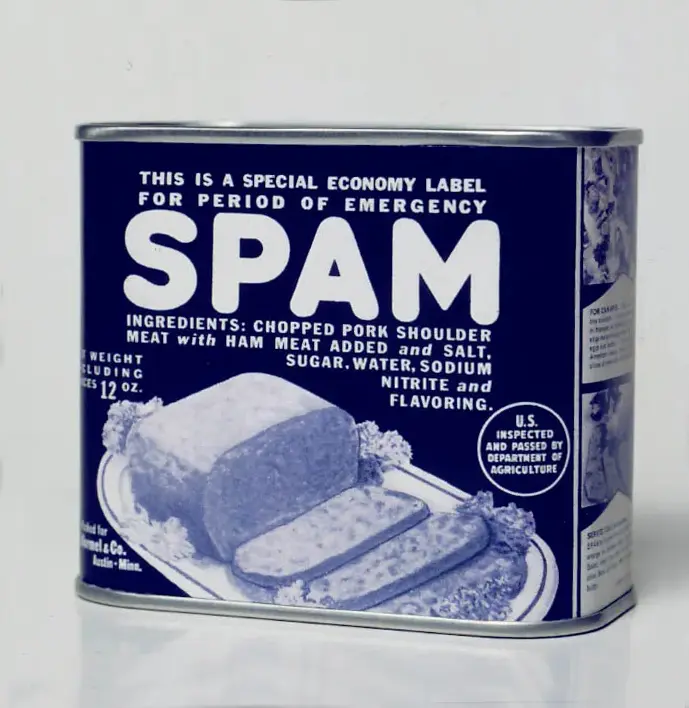 A vintage Hormel SPAM can from 1937 - the year Hormel renamed their "Spiced Ham" product to the shorter "SPAM" that Monty Python would later mock and tech nerds would borrow for junk email.
A vintage Hormel SPAM can from 1937 - the year Hormel renamed their "Spiced Ham" product to the shorter "SPAM" that Monty Python would later mock and tech nerds would borrow for junk email.
The absurd repetition gave email spam its name.
In 1996, frustrated admins formed MAPS (Mail Abuse Prevention System) and launched the first DNS-based blocklist (RBL) of known spammer IPs. Blacklists were born so net admins could say, "Fuck you, spammer!" and drop connections instantly. (Spam didn't stop, but it had a boss now.)
In the 2000s spam exploded with the growth of broadband and open relays. Love it or hate it, spam drove much of email's history: it forced companies to develop filters, spurred anti-spam laws like CAN-SPAM (2003) and even birthed entire industries (spam-filter software, botnet takedowns, etc.). By the late 2000s, half of all email traffic was spam - a digital plague that mainstreamed terms like "spamfilter" and "blacklist."
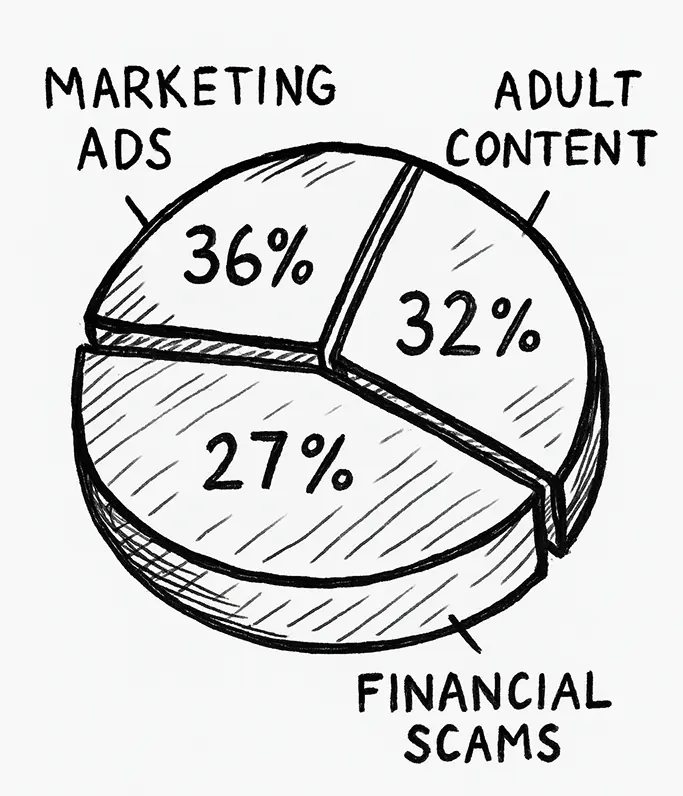 Breakdown of spam content: 36% marketing ads, 32% adult content, 27% financial scams, with most dangerous scams being phishing attempts.
Breakdown of spam content: 36% marketing ads, 32% adult content, 27% financial scams, with most dangerous scams being phishing attempts.
Global Spam Today: The Fuckin' Numbers
We hear that "half of all emails are spam" tossed around - and it's pretty damn accurate. Recent surveys crunching global email traffic show about 45-46% of all email is unsolicited crap. To put it in your face: about 160 billion spam emails are sent every damn day worldwide. That's nearly one out of every two messages you see.
Which countries spew the most spam? The USA leads (~8.0 billion spam/day) and China is close behind (~7.6 billion/day). (The top 10 spam-sending countries combined pump out over 2,184 metric tons of CO₂ every single day in wasted email energy - literally 5.3 million car-miles of pollution from spam!) Even France and Russia clock in with nasty email output.
What's Actually In Your Spam Folder
A lot of that spam is plain old advertising or porn. One analysis found spam content breaks down roughly into 36% marketing ads (discounts, sales, MLM pitches), 32% porn/escort junk and 27% financial (loans, banking, crypto shit). Only a few percent are blatant scams, but most of those scams are phishing (fake login pages, "your account is hacked" bait, etc.).
Some quick stats to make you feel better (or worse)
- 160 billion spam emails fly every day, roughly 46% of total email.
- 96.8% of Internet users have seen spam in their inbox.
- 45% of all email traffic was spam as of 2021 (and it's hovered around that ever since).
- The US, China and Russia top the list of spam sources.
- 36% of spam is marketing, 32% adult, 27% financial, with most of the scamming (2.5%) being phishing.
Clearly spam ain't going away.
How Spam Filters and Detection Actually Work
Waging war on spam is complex. Modern spam filtering is basically a multi-layer defense system. Think of it like an onion or those annoying Reese's commercials - many layers. Big email providers (Gmail, Outlook, Yahoo) and corporate mail servers don't just do one thing; they chain together blacklists, content checks, authenticity checks, AI engines, etc.
- Blacklists (DNSBLs): If an email comes from an IP that's on a known-spammer list (like the classic Spamhaus or Barracuda RBLs), it gets dumped to Spamville immediately.
- Bayesian/Content Filters: These filters learn from text patterns: they calculate how likely an email is spam by the words it contains.
- Rule-based filters: These look for specific triggers - e.g. lots of exclamation points, suspicious attachments, certain phrases.
- Authentication checks: Newer defenses check SPF/DKIM/DMARC - basically, "Does the sender really own this domain or IP?"
 Modern spam filtering uses multiple layers: blacklists, content analysis, authentication checks and AI - creating a multi-layered defense system.
Modern spam filtering uses multiple layers: blacklists, content analysis, authentication checks and AI - creating a multi-layered defense system.
 Google's AI systems analyze billions of emails daily, achieving 99.9% spam blocking accuracy through machine learning and user feedback.
Google's AI systems analyze billions of emails daily, achieving 99.9% spam blocking accuracy through machine learning and user feedback.
Machine Learning & AI: Today's giants (like Gmail) rely heavily on AI trained on huge datasets. Google proudly says it blocks 99.9% of spam, phishing and malware before you see it. Their systems use sophisticated ML models (neural nets, decision trees, etc.) that look at everything: sender IP reputation, links, images, how users have reacted to similar messages and more.
User reports ("I marked this as spam") feed back into the model so it learns new tricks in real time. Gmail's FAQ flat-out says, "We rely on machine learning powered by user feedback to catch spam" and they consider factors from IP to authentication to user flags.
Despite all this, spam still slips through (and has for 20+ years). Filters have their weaknesses - spammers evolve. They use botnets of malware-infected PCs to send spam from fresh IPs, they obfuscate text in images or simply play whack-a-mole with domains.
Common Spam Scams and Schemes
Spam isn't just boring ads. The current scene of spammy nastiness includes:
Phishing Emails: By far the biggest threat. Fake login pages for your bank, PayPal or your corporate VPN. Credential-stealing forms disguised as customer support or HR. APWG's recent reports show phishing is off the charts. In Q4 2024, APWG logged ~989,000 phishing attacks, up from ~877,000 in mid-2024.
Business Email Compromise (BEC): This is where a spammer impersonates a CEO or vendor and tricks your finance team. Think: "Urgent wire transfer to supplier" or "Can you buy iTunes cards and email me the codes?" These scams are spiking. The average requested amount? About $129K per grab.
Malware Spam: "Click this attachment" is literally a mantra for evil. Spam often carries ransomware, trojans or spyware - hidden in ZIPs, malicious Word docs or download links. Common names: Fake invoices, shipping notifications ("your package"), tax refunds, etc.
The takeaway: phishing/social engineering forms the core, but malicious attachments and scams ride the same rails. Some stats to freak you out: 1.2% of all emails sent globally are outright malicious phishing attempts - that's 3.4 billion phishing emails every day. Even a low click rate yields huge numbers of compromised accounts.
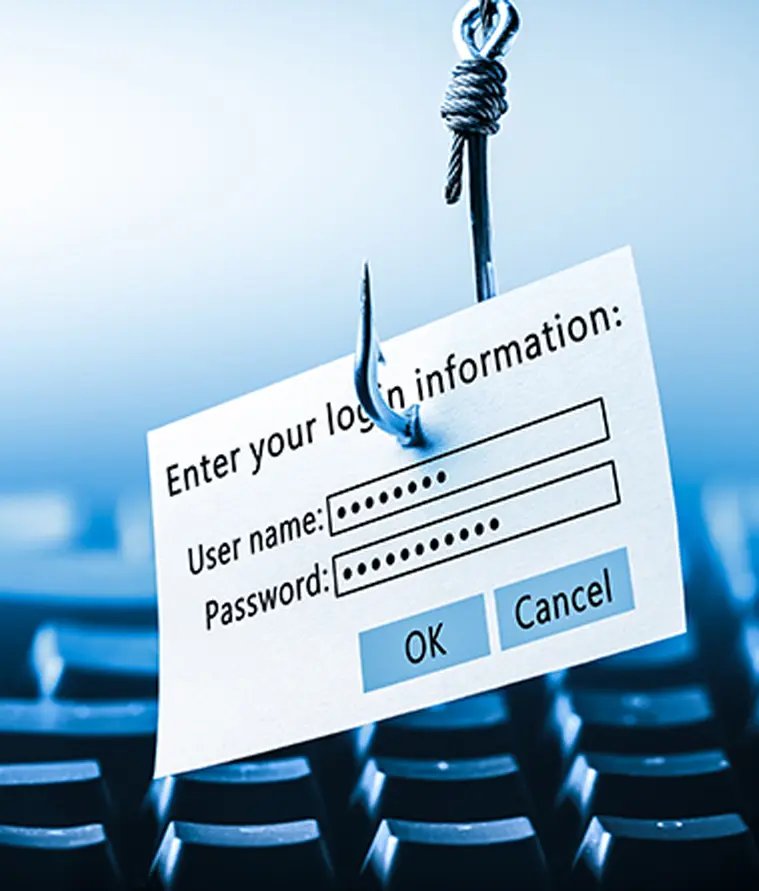 Phishing attacks hit over 1 million per quarter in 2025, with 3.4 billion malicious emails sent daily worldwide.
Phishing attacks hit over 1 million per quarter in 2025, with 3.4 billion malicious emails sent daily worldwide.
How Spam Screws Us (Impact on People & Business)
Okay, we get it: spam is annoying. But it's more than a minor annoyance - it costs real time, money and even our sanity:
Wasted Time & Productivity: Someone has to click "delete" a hundred times a day. Companies bleed cash on this. For example, imagine a 45-person office, each spending just 5 minutes per day deleting junk (they're quick!). At €30/hour labor, that's €22,500 wasted every year on spam triage alone. That's not pocket change - it's enough to buy a car.
Psychological Toll: It's not fun to constantly sift truth from crap. A recent poll found 96.8% of people have been hit by spam or phishing attempts and over 68% said it caused "some mental distress" - stress, annoyance, even anxiety.
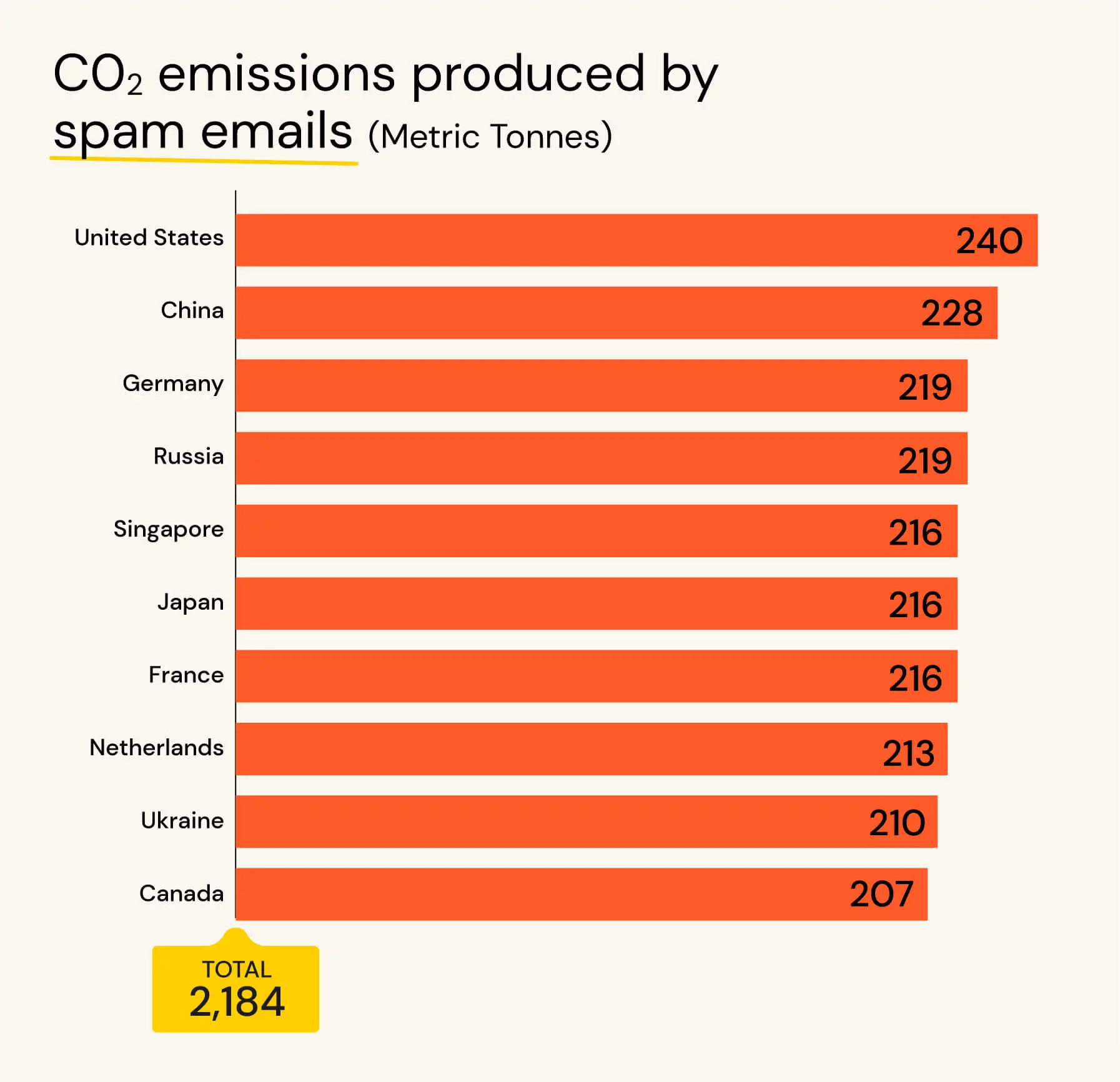 The environmental cost of spam: 160 billion daily emails generate thousands of tons of CO₂ from wasted server energy and data transfer.
The environmental cost of spam: 160 billion daily emails generate thousands of tons of CO₂ from wasted server energy and data transfer.
Security & Financial Damage: Every phishing email is a potential catastrophe. Users clicking a malicious link or giving up credentials can lead to breached accounts, stolen identities, stolen funds or a full-blown ransomware lockdown.
Infrastructure Costs: Spam clogs networks and servers. Companies have to buy extra bandwidth, storage and filtering systems just to handle the garbage load. Some firms now spend millions on firewalls and anti-spam appliances.
Environmental Footprint: We mentioned CO₂ already - spam emails add a not-insignificant carbon footprint to our digital lives. All the extra data transfer and processing eats energy.
In sum, spam is more than just "internet clutter." It zaps productivity, threatens security and even messes with our heads. And while filters catch most of it, every so often a dangerous phishing wave slips through and reminds us why we fight spam so hard.
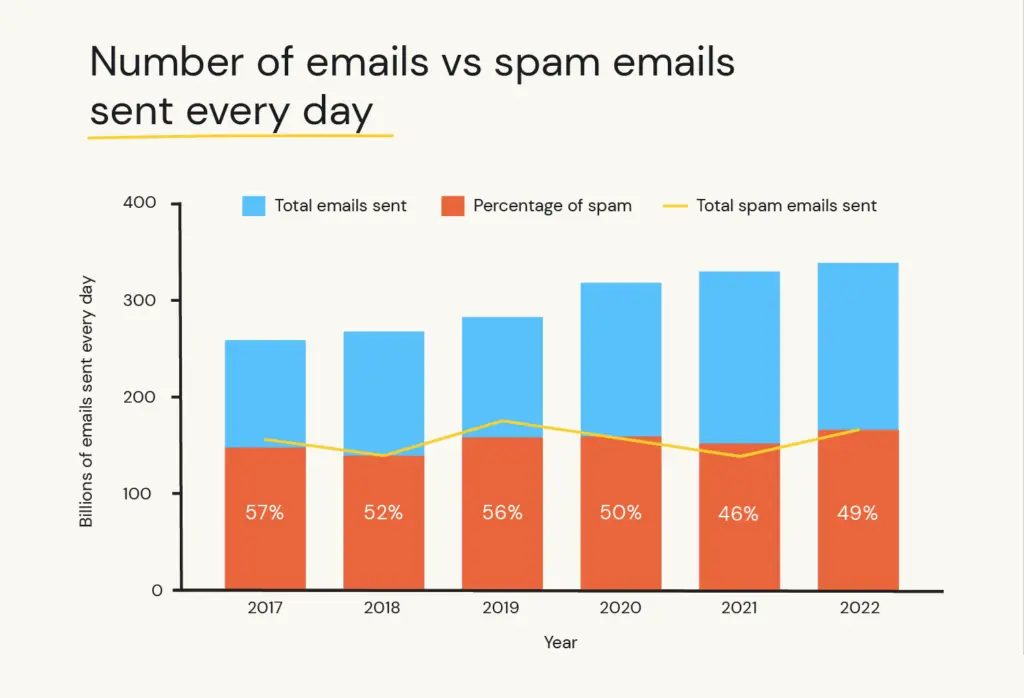 Global spam as percentage of total email traffic showing the rise to over 50% and recent plateau around 49%. From the early 2000s explosion to today's steady state of digital noise, spam has become a permanent fixture of email infrastructure.
Global spam as percentage of total email traffic showing the rise to over 50% and recent plateau around 49%. From the early 2000s explosion to today's steady state of digital noise, spam has become a permanent fixture of email infrastructure.
TL;DR
- Etymology matters: From Monty Python's absurd repetition to today's 160 billion daily emails, spam got its name from cultural comedy, not corporate marketing.
- Scale is staggering: Nearly half of all email is spam, costing billions in productivity and generating massive environmental waste.
- Filters are fighting back: Modern AI systems catch 99.9% of spam through multi-layered defenses, but spammers keep evolving.
- Phishing is the real threat: While most spam is just annoying ads, the 3.4 billion daily phishing attempts pose serious security risks.
The next time you see "SPAM" in your junk folder, remember: you're looking at the digital descendant of canned meat, Monty Python sketches and 50 years of internet evolution. It's annoying as hell, but it's also a fascinating artifact of how human communication adapts to new technologies.